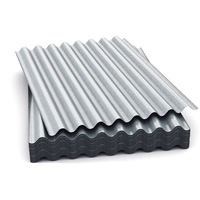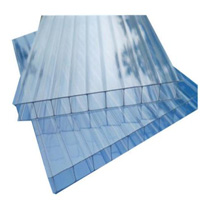Roof is the topmost portion of a building, which protects the building and its inhabitants from the sun, rain, wind, snow and all atmospheric conditions. They should be constructed keeping in view the climatic changes of a place, availability of materials and also depends on architectural considerations.
Roofing materials are of various types, and their selection depends upon the climatic conditions of a place, availability of materials, fabrication facility and the building owner's budget. Most commonly used materials for pitched roofs are
AC Roofing sheets
Asbestos cement (AC) is a material which contains 15 per cent of asbestos fibres evenly distributed and pressed with cement. They are manufactured in large sizes, with corrugation or with Trafford to get good strength with less thickness.
The width of an AC sheet ranges from 1.0 - 1.2 m and length from 1.75 - 3.0 m. This type of roofing is both waterproof and economical but has poor thermal resistance. These sheets are commonly used as roofing materials in warehouses, godowns and large halls.
GI Roofing sheets
Galvanized iron corrugated sheets are manufactured in sizes 1.0-1.2 m wide and 1.65 m long. They are iron rust-proof due to galvanization. These sheets are durable, fireproof, lightweight and no maintenance is required.

They are used as covering materials for warehouses, godowns, sheds, etc.
Plastic Roofing sheets
Corrugated PVC sheets are also used as roofing materials and can be preferred along with AC sheets and G.I sheets. They provide natural lights and are rust-proof and lightweight. They are maintenance-free and resistant to corrosion, fire, chemical, thermal and also hygienic.

These sheets should not be slid over rough surfaces or against each other and should be handled with care to avoid scratches.
They should be stored neatly, supported on a firm base and at a slight slope and ensure proper ventilation. Their installation is the same as the AC or G.I sheets.
Fibre Roofing sheets
The fibre reinforced sheets are available in three types, and they are
Fibre-reinforced cement sheets: Cement sheets can withstand the rigorous action of weather without losing their quality. They are corrugated same as AC and GI sheets to add more strength. These sheets are resistant to fire, moisture and termite and do not warp. They allow uniform diffused lights and need no maintenance.

Fibre Reinforced Plastic (FRP) sheets: These sheets are available in smooth and wrinkled surfaces. They can also be used for other purposes other than roofing.
Fibre Glass Roofing: They are of various sizes and available in attractive colours like natural, white, green, red, blue, orange and many other shades. These are very easy to install compared to other conventional sheets. Commonly used as covering materials for factories, cold storages, swimming pools, terrace gardens, etc.
Comparison between GI and AC Sheets
GI Sheets - Galvanized iron corrugated sheets
- These sheets are thin
- They are lightweight
- Chances of corrosion
- They are unbreakable and easy to handle
- Noisier, if something falls over them
- They have Low fire-resistance
- They have Low resistance to acid
- The initial cost is high
AC Sheets- Asbestos cement
- They are not as thin as GI sheets
- They are slightly heavier
- Corrosion-resistant
- Chances of breaking
- Less noisy
- They have good fire resistance
- They have more resistance to acid
- The initial cost is low
Check Out: Types of False Ceiling Designs & More

















Roofsheet
posted on Sep 18, 2019 10:40:21 AM